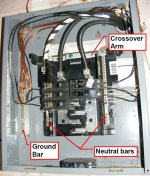hosspuller
Veteran Member
- Joined
- Oct 9, 2008
- Messages
- 1,786
- Location
- Piedmont Triad, NC
- Tractor
- Didn't intend to have a Deere fleet - it just happened 310C, F915,102, 5200 & 5065E
What do you do if the ground and neutral bars are joined in the panel? Just break a piece of the connecting bar out?
Look closely... there will be a portion of the neutral bar that is pre scored to remove or there is a piece that bonds the box to the neutral bar.
